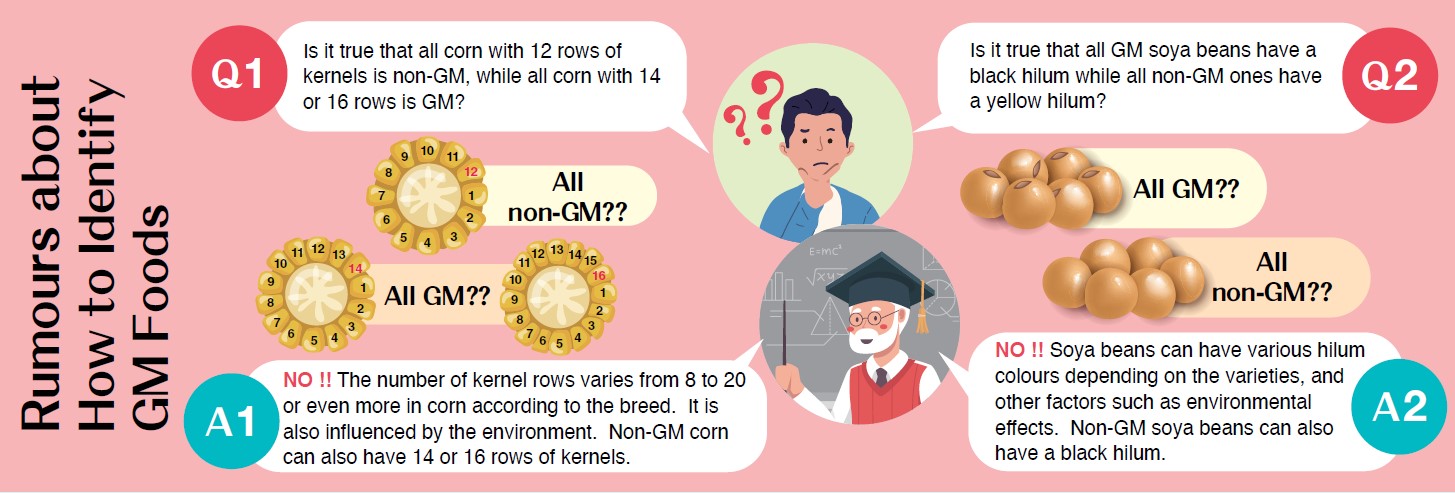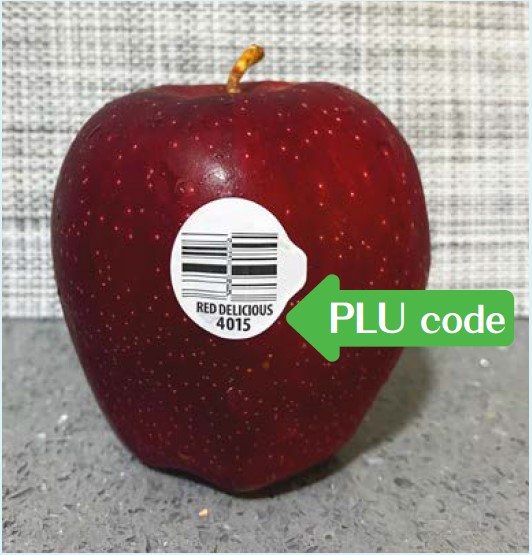Can we identify genetically modified foods in the market from their
appearances or Price Look-Up codes?
Have you ever heard of the saying that we can identify genetically modified (GM) foods simply by observing their appearances, or checking their Price Look-Up (PLU) codes?
You may wonder whether the above saying is true. However, these are just rumours and let’s take a look at the reason behind. We will also talk about the methods which are used to identify GM foods in the market.
Can we tell whether our foods are GM from their appearances only?
There are rumours that all corn with 12 rows of kernels is non-GM, while all corn with 14 or 16 rows of kernels is GM. There are also other rumours that people can tell whether soya beans are GM or not by observing the colour of the hilum that all GM soya beans have a black hilum while all non-GM ones have a yellow hilum.
In fact, the number of kernel rows varies from 8 to 20 or even more in corn according to the breed. Non-GM corn can also have 14 or 16 rows of kernels, in contrast to the saying of the rumour that all corn with 14 or 16 rows of kernels is GM. The number of kernel rows is also influenced by the environment. Even the same species of corn cultivated under different environmental conditions may have different numbers of kernel rows. For example, plant stresses such as drought can reduce the number of kernel rows produced. Therefore, the number of kernel rows alone does not reflect the GM status of corn.
It is known that soya beans can have various hilum colours such as black, yellow, grey and brown, etc. depending on the varieties and also other factors such as environmental effects (e.g. changing temperatures and humidity during seed development). Therefore, non-GM soya beans can also have a black hilum and therefore the saying that a black hilum indicates GM soya beans is not true.
In short, we cannot tell whether corn and soya beans are GM or not simply from their appearances only (see Figure 1).
 Figure 1: Rumours about how to identify GM foods
Figure 1: Rumours about how to identify GM foods
Can we tell the GM status of our foods from PLU codes?
PLU codes are 4 to 5 digit numbers which have been used by retailers since 1990 to make check-out and inventory control easier, faster, and more accurate. They are mainly used on loose, fresh produce. A PLU code can be placed on a small sticker on the individual item, or printed on the outside of the open bag for certain items such as grapes or cherries, etc. (see Figure 2). PLU codes are assigned by the International Federation for Produce Standards (IFPS), which is composed of national produce associations from around the globe.

Figure 2: A PLU code which appears on a small sticker on loose, fresh produce
There have been on and off reports about the use of PLU codes on produce stickers to distinguish between conventionally-grown, GM and organic products. A “8” prefix added to a PLU code was believed to signify the produce is GM. In fact, though the “8” prefix was once reserved for GM produce items, the prefix was never used at retail.
PLU codes are not intended to convey information to consumers apart from being tools for inventory control, except the prefix “9” currently used in front of the 4-digit PLU code for the conventionally grown item to identify organically grown produce. For example, the PLU code for a standard yellow banana is 4011 where an organically grown standard yellow banana would be 94011. However, to check if the item is a certified organic product, consumers are encouraged to read organic labels which are based on established organic standards before purchase.
As the adoption of PLU codes has gained traction, the IFPS has committed to transitioning the previously unused “8” prefix to accommodate an increase in varieties of fresh produce items as they enter the market. In the future, the IFPS will begin assigning PLU codes utilising the 83000 series and 84000 series for conventionally grown produce items and the corresponding organic item, respectively.
What methods can be used to identify GM foods in the market?
Basically, physical appearances of most GM foods are similar to their conventional counterparts. Biochemical analyses are ways to differentiate them.
There are two main approaches to test for GM foods in the market based on the detection of the deoxyribonucleic acid (DNA) introduced or the proteins expressed in the GM organisms used to make the food products. For example, the Polymerase Chain Reaction (PCR) is used to detect the presence of recombinant DNA resulted from genetic modification, while the Enzyme Linked Immunosorbent Assay (ELISA) and Lateral Flow Devices (LFD) are used to detect the presence of the modified proteins resulted from genetic modification.
Both PCR and ELISA are laboratory-based techniques which require specialised equipment and trained personnel. LFD can be rapidly conducted on-site for screening purposes, but it is less sensitive and still requires specific testing kit to perform.